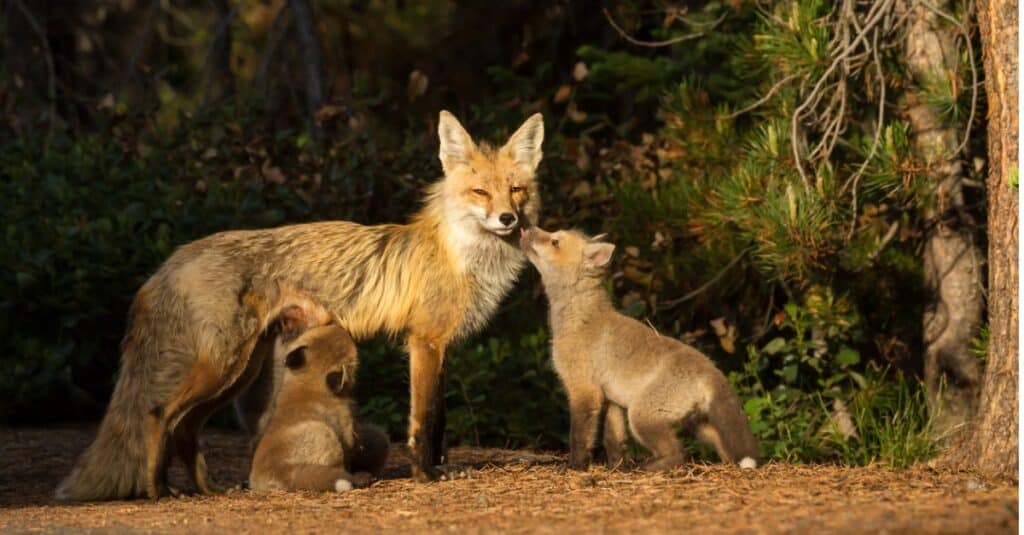Foxes are small to medium sized omnivorous mammals. They are well known for their ability to flit silently through the shadows while relying on their excellent senses to search for prey. They are opportunistic predators but are skilled hunters and highly adaptable. But where do they live? Join us as we discover everything you need to know about a foxes habitat and where they live.
Where do Foxes Live?

Foxes live in almost every type of habitat on Earth, from forests, to deserts, to the Arctic!
©iStock.com/Svetlana Belkina
Foxes live in a surprising amount of habitats including forests, grasslands, deserts, mountains and even the Arctic!
There are twelve species of true foxes (genus Vulpes) and around 25 other species that are commonly known as foxes, or “false foxes” due to their close resemblance. Foxes are found on every continent around the world apart from Antarctica. Therefore, it should come as no surprise that they actually live in a variety of different habitats, depending on the location and the species. Foxes are extremely adaptable and that has helped them to survive – and even thrive – in some pretty harsh conditions. Here are some of the habitats where foxes live.
Forests, Woodlands & Grassland
Probably the most common and best known habitat of foxes is forests, woodlands, and grassland. These habitats are home to many different species of foxes and provide a rich source of food – both prey animals and fruit. They also provide plenty of cover for them to build their dens (more on dens later) and a good source of water by rivers and streams. Often a foxes home range can incorporate both forest or woodland and grassland habitat which gives them greater diversity when hunting and foraging.
Deserts
Desert foxes live in some of the hottest and driest climates in the world. In these dry deserts they have to deal with extreme heat and very little water. Quite often, desert foxes – such as fennec foxes – have to rely on moisture from their prey as water is so scarce. They also rely on their extra large ears to help dissipate their body heat. Desert foxes rely on their complex dens to provide shelter from the intense heat of the daytime sun. This is because the temperature underground is much cooler than the temperature above ground. Dens are usually made in sand dunes in areas with some vegetation.
Arctic & Alpine Tundra

Arctic foxes live in one of the harshest habitats around
©rokopix/Shutterstock.com
Quite possibly the harshest habitat that any fox lives in is the snowy range of the Arctic and alpine tundras. You’d easily be forgiven for assuming that it’s only Arctic foxes that brave these conditions, but actually red foxes live there too. Their range overlaps and occasionally red foxes dig Arctic foxes out of their dens and kill them.
These tundras are mostly treeless, snowy, windy and extremely cold – the average temperature is between -34 and -6°C. Arctic foxes in particular have adapted extremely well to these extreme conditions. They have thick fur, including furry paw pads, and a keen sense of smell to detect prey that is buried in several inches of snow. Much of the area in the Arctic tundra is covered in permafrost. Incredibly, Arctic foxes use this to store and preserve their prey in their dens.
Mountains & Plateaus
Some foxes live at extremely high elevations on mountains and plateaus. Tibetan foxes live high up on the vast Tibetan plateau between 11,500 and 17,100 feet, while other foxes – such as culpeo foxes – live on the slopes of mountains. Mountain habitats involve lots of rugged and often rocky slopes. These slopes provide plenty of cover for them – both for hunting and making dens. Plateaus are high plains which usually have vast grasslands as well as steep hills. They also often have the headwaters (starting point / source) of many rivers and streams and these provide a range of ecosystems and an abundance of prey.
Fox Dens
As we’ve already mentioned, foxes make dens (also known as setts, or earths). They mainly use these to raise their young in and store food. Dens are dug in the ground by the fox, or sometimes they take over a vacated den from another animal. The entrance is usually in an area with plenty of vegetation or cover – such as under bushes or between rocks.
Dens consist of a series of tunnels and several dug-out areas which have different functions. The size of the den varies, but most have more than one entrance and are up to eight feet deep. The length of the tunnels also varies. The average tunnel is 15 to 25 feet long, although more than 50 feet long isn’t uncommon. The basic layout of a fox den is an entrance, ramp downhill, main den, and food store. Most dens are sufficiently large enough for the vixen to give birth and raise the cubs in.
Foxes generally always have a cache of food in their den. They store food for the pregnancy, feeding the cubs, and during winter. This is why foxes often get a bad name for themselves regarding “killing sprees” (ie in a chicken coop) and leaving a trail of dead animals behind. However, if they weren’t disturbed then the fox would take away everything they’ve killed and store it in their den.
The main den is used for raising the cubs so the vixen can raise them safely. Cubs usually remain in the den for around six weeks before they begin to explore the great outdoors. However, they still stay close for a while longer as they gradually learn to forage and fend for themselves.

Fox dens are a series of tunnels and dug-outs and can be more than 20 feet long
©iStock.com/Wendy/Jeff Sparks/Torquemada
Urban Foxes
There is an increasing number of urban foxes in cities and towns and they have learned to adapt to the environment that they live in. Unlike typical foxes, urban foxes make their dens underneath sheds, in railway embankments, under tree roots, or really anywhere they can make themselves a home and feel safe. Urban foxes often feed on any rats in the area and search through rubbish for scraps. Quite often, people even put out food for them and regular feeding attracts dens in the area. However, even though they have adapted to their urban habitat, life is hard for urban foxes and death due to road accidents is quite common.
The photo featured at the top of this post is © Jackie Connelly-Fornuff/Shutterstock.com
Thank you for reading! Have some feedback for us? Contact the AZ Animals editorial team.






